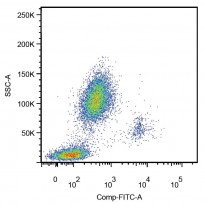ARG62728
anti-CD14 antibody [MEM-18] (FITC)
anti-CD14 antibody [MEM-18] (FITC) for Flow cytometry and Human,Primates
Developmental Biology antibody; Immune System antibody; General Lymphocyte Marker Study antibody; Macrophages and neutrophils antibody
概述
| 产品描述 | FITC-conjugated Mouse Monoclonal antibody [MEM-18] recognizes CD14 |
|---|---|
| 反应物种 | Hu, NHuPrm |
| 应用 | FACS |
| 特异性 | The clone MEM-18 reacts with CD14, a 53-55 kDa GPI (glycosylphosphatidylinositol)-linked membrane glycoprotein expressed on monocytes, macrophages and weakly on granulocytes; also expressed by most tissue macrophages. In human, the epitope recognized by MEM-18 is located between amino acids 57-64. HLDA III; WS Code M 253 HLDA IV; WS Code M 314 HLDA V; WS Code M MA087 HLDA VI; WS Code M MA95 |
| 宿主 | Mouse |
| 克隆 | Monoclonal |
| 克隆号 | MEM-18 |
| 同位型 | IgG1 |
| 靶点名称 | CD14 |
| 抗原物种 | Human |
| 抗原 | A crude mixture of human urinary proteins precipitated by ammonium sulphate from the urine of a patient suffering from proteinuria. |
| 偶联标记 | FITC |
| 別名 | CD antigen CD14; Myeloid cell-specific leucine-rich glycoprotein; Monocyte differentiation antigen CD14 |
应用说明
| 应用建议 |
|
||||
|---|---|---|---|---|---|
| 应用说明 | * The dilutions indicate recommended starting dilutions and the optimal dilutions or concentrations should be determined by the scientist. |
属性
| 形式 | Liquid |
|---|---|
| 纯化说明 | The purified antibody is conjugated with Fluorescein isothiocyanate (FITC) under optimum conditions. The reagent is free of unconjugated FITC and adjusted for direct use. No reconstitution is necessary. |
| 缓冲液 | PBS, 15 mM Sodium azide and 0.2% (w/v) high-grade protease free BSA |
| 抗菌剂 | 15 mM Sodium azide |
| 稳定剂 | 0.2% (w/v) high-grade protease free BSA |
| 存放说明 | Aliquot and store in the dark at 2-8°C. Keep protected from prolonged exposure to light. Avoid repeated freeze/thaw cycles. Suggest spin the vial prior to opening. The antibody solution should be gently mixed before use. |
| 注意事项 | For laboratory research only, not for drug, diagnostic or other use. |
生物信息
| 数据库连接 |
Swiss-port # P08571 Human Monocyte differentiation antigen CD14 |
|---|---|
| 基因名称 | CD14 |
| 全名 | CD14 molecule |
| 背景介绍 | CD14 is a 55 kDa GPI-anchored glycoprotein, constitutively expressed on the surface of mature monocytes, macrophages, and neutrophils, where serves as a multifunctional lipopolysaccharide receptor; it is also released to the serum both as a secreted and enzymatically cleaved GPI-anchored form. CD14 binds lipopolysaccharide molecule in a reaction catalyzed by lipopolysaccharide-binding protein (LBP), an acute phase serum protein. The soluble sCD14 is able to discriminate slight structural differences between lipopolysaccharides and is important for neutralization of serum allochthonous lipopolysaccharides by reconstituted lipoprotein particles. CD14 affects allergic, inflammatory and infectious processes. |
| 生物功能 | In concert with LBP, binds to monomeric lipopolysaccharide and delivers it to the MD-2/TLR4 complex, thereby mediating the innate immune response to bacterial lipopolysaccharide (LPS). Acts via MyD88, TIRAP and TRAF6, leading to NF-kappa-B activation, cytokine secretion and the inflammatory response. Up-regulates cell surface molecules, including adhesion molecules. [UniProt] |
| 研究领域 | Developmental Biology antibody; Immune System antibody; General Lymphocyte Marker Study antibody; Macrophages and neutrophils antibody |
| 预测分子量 | 40 kDa |
| 翻译后修饰 | N- and O- glycosylated. O-glycosylated with a core 1 or possibly core 8 glycan. |
检测图片 (1) Click the Picture to Zoom In
克隆号文献








